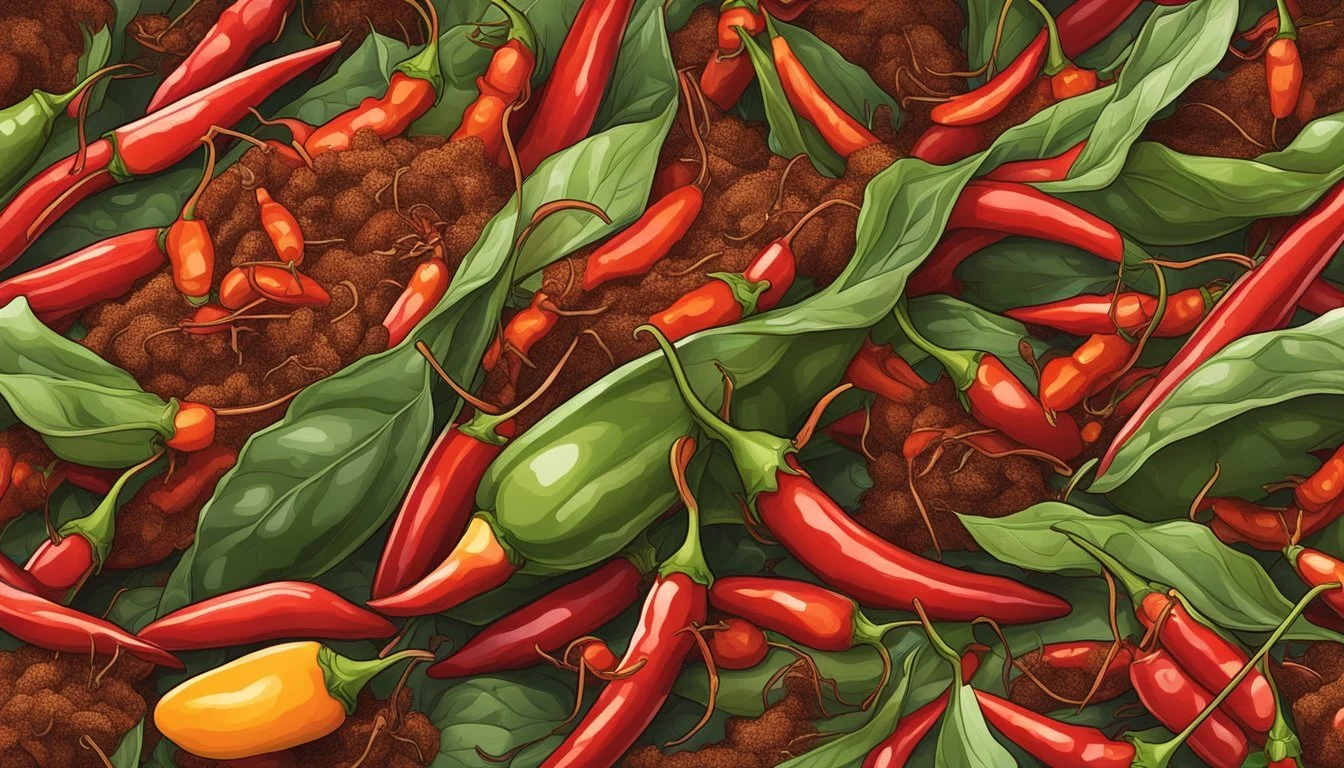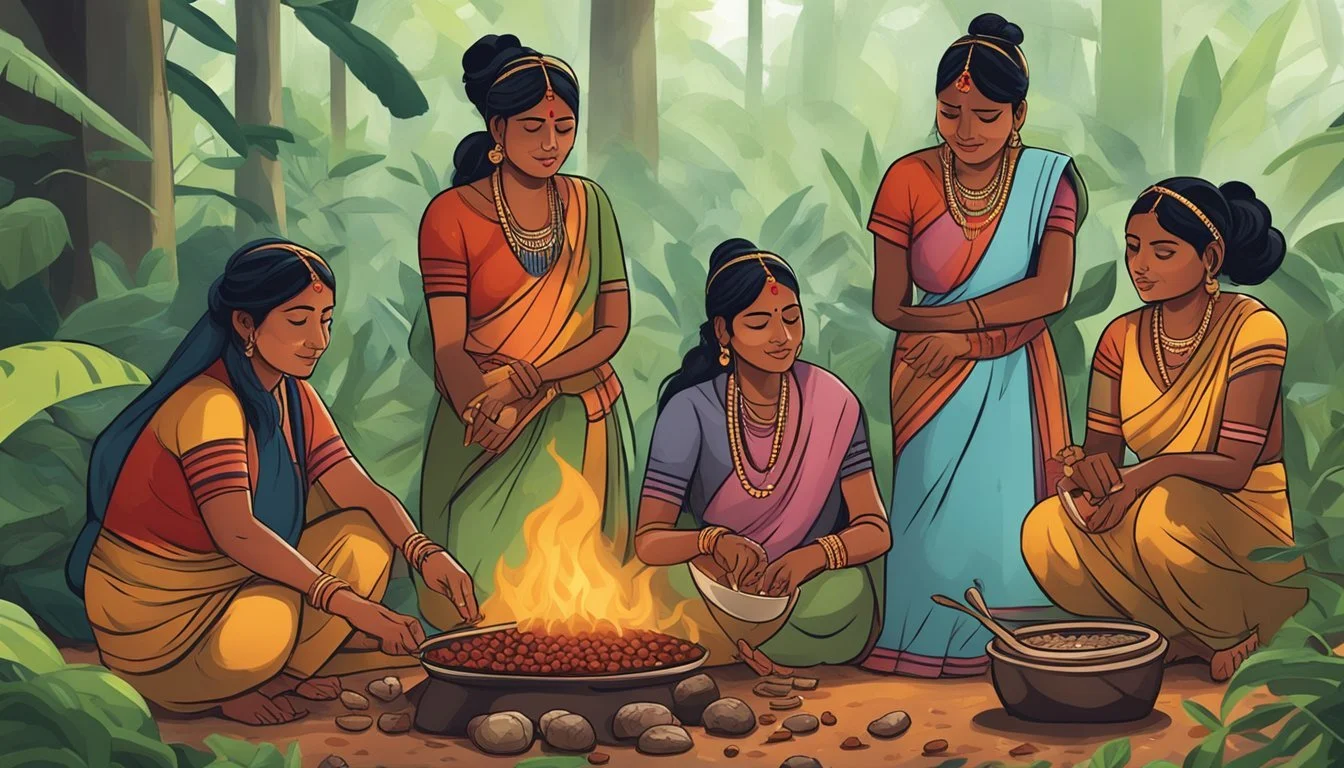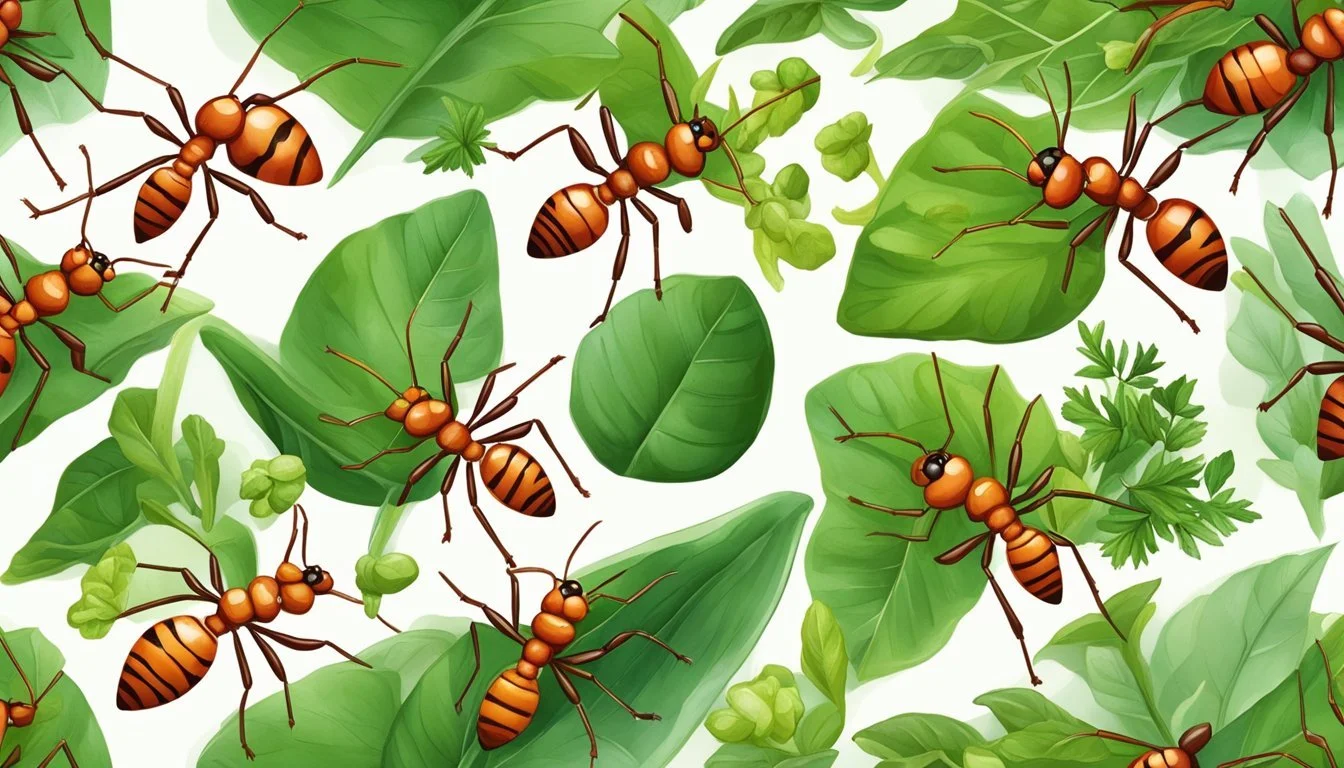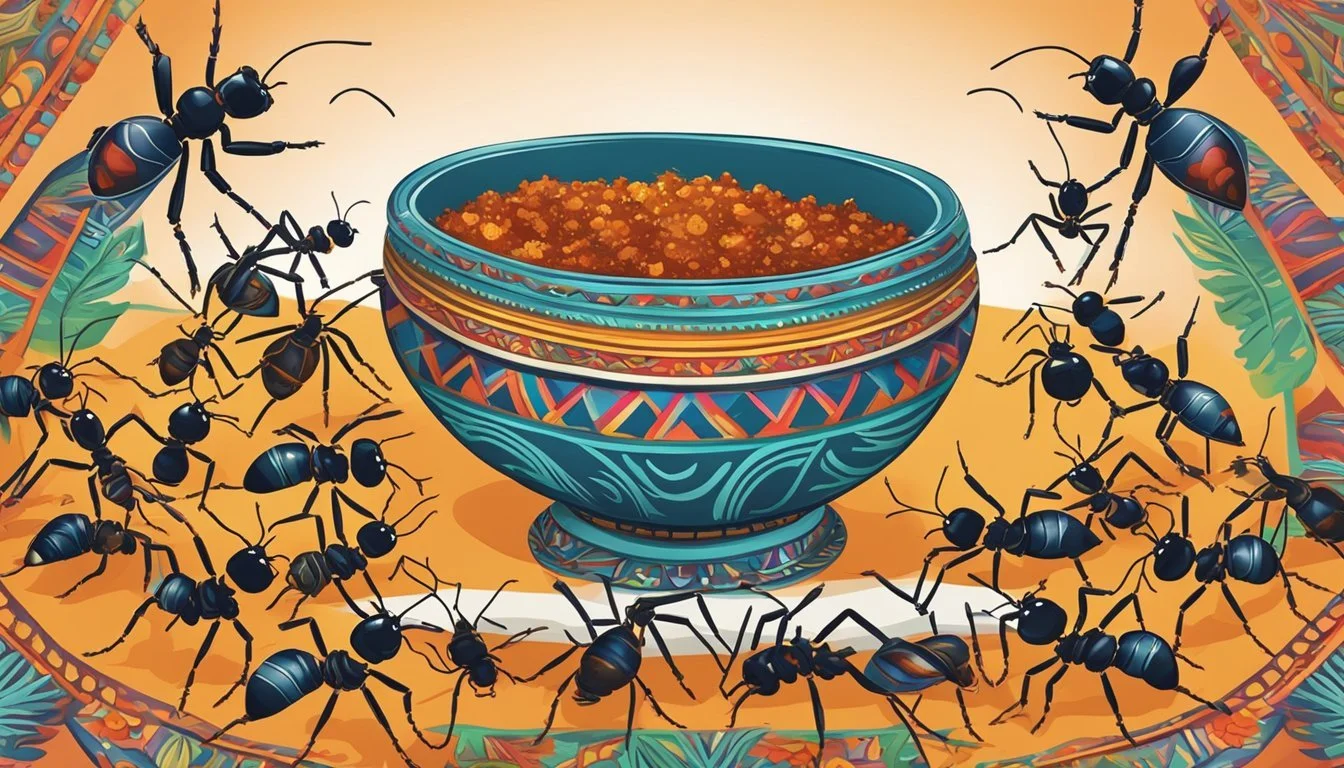Red Ant Chutney
Unveiling the Spicy Delight of Indian Tribal Cuisine
Red Ant Chutney is a distinctive delicacy that hails from the Indian tribal cuisine, known particularly among the tribes of Odisha, Jharkhand, and Chhattisgarh. Crafted from red weaver ants and their eggs, this chutney is not only a spicy accompaniment to meals but also a testament to the resourcefulness and culinary traditions of the tribes. Renowned for its unique flavor and health benefits, the chutney has gained popularity, further propelled by the acclaim from celebrity chef Gordon Ramsay who lauded its taste.
The preparation of this chutney involves collecting red weaver ants, a task that requires skill and care as the ants are known to bite fiercely. These ants are then crushed and combined with local spices and ingredients to create a chutney that is both spicy and tangy. Despite its simple ingredients, Red Ant Chutney emerges as a culinary delight that offers a burst of flavors to the palate.
Recognized for its uniqueness and the meticulous traditional ways of its preparation, Red Ant Chutney has been honored with a geographical indication tag, highlighting its cultural and regional significance. This spicy delight is more than just a condiment; it encapsulates the vibrancy and the innovative spirit of Indian tribal cuisine.
Historical Significance and Origin
Red ant chutney, known for its unique flavor and nutritional benefits, traces back to the indigenous customs of the Indian tribes predominantly from regions like Odisha, Jharkhand, and Chhattisgarh. It epitomizes entomophagy in Indian tribal cuisine and has garnered attention for its cultural significance and potential for a Geographical Indication tag.
Tribal Traditions and Entomophagy
In the dense forests of Odisha, Chhattisgarh, and Jharkhand, tribal communities have incorporated the practice of eating insects, known as entomophagy, into their diets for centuries. Red ant chutney, locally referred to as kai chutney in some areas, is not just a culinary delight but an embodiment of this ancient tradition. Harvested from the nests built by weaver ants, this chutney is made by meticulously processing both the ants and their larvae.
Geographical Indication and Cultural Importance
The unique cultural identity of red ant chutney is closely tied to the tribal regions of India, prompting calls for Geographical Indication (GI Tag) recognition. Especially in Bastar, a district in Chhattisgarh renowned for its tribal heritage, this chutney holds a special place. A GI Tag would acknowledge the chutney’s cultural significance and the traditional knowledge of the tribal communities. Historical links trace back to the time of the Bhanj Dynasty at the Belgadia Palace, where this local specialty was part of the culinary heritage.
Famous Affiliations and Recognitions
Internationally acclaimed chef Gordon Ramsay showcased his penchant for this spicy treat when he visited India, labeling the red ant chutney as "delicious." This endorsement brought the chutney into the spotlight, extending its fame beyond the Indian borders and revealing its potential as a kind of ambassador for indigenous cuisine. The chutney’s renown reflects the growing curiosity and appreciation for tribal food traditions globally.
Ingredients and Preparation
This section provides an insight into the exotic ingredients and meticulous preparation methods that go into creating the unique Indian tribal cuisine, Red Ant Chutney.
Key Components of Red Ant Chutney
Red Ant Chutney primarily comprises weaver ants, their eggs (pupae), and a mixture of traditional Indian spices. The key ingredients are:
Weaver ants and pupae: Rich in protein and formic acid.
Ginger and Garlic: For strong, aromatic flavors.
Green Chillies: They add heat to the chutney.
Coriander Leaves: Fresh herbs for a burst of flavor.
Tamarind: Adds a tangy taste to balance the flavors.
Salt: To enhance overall taste.
Sugar: A hint of sweetness to complement the spice.
These ingredients are blended to achieve the right balance of flavors that define this spicy delicacy.
Harvesting and Handling of Red Ants
The harvest of weaver ants and their pupae is a delicate process that involves carefully collecting ants from the trees where they reside. Harvesters must be skillful to avoid the ant's defensive bites. Once collected, the ants are typically dried in preparation for making the chutney. Handling of ants is done with respect to traditional practices that have been passed down through generations.
Culinary Techniques and Methods
To make the chutney, traditional culinary techniques are employed. The preparation involves:
Crushing dried ants and pupae into a fine mix.
Combining this mix with finely chopped ginger, garlic, green chillies, and coriander leaves.
Blending the ingredients along with tamarind paste, salt, and a pinch of sugar.
The ingredients are ground into a paste, often using a mortar and pestle to release their flavors and achieve the desired consistency. It can be served with a variety of vegetables or as a side to main dishes, adding a nutrient-rich, spicy kick to meals.
Nutritional and Medicinal Benefits
Red ant chutney, a traditional dish from the tribal regions of Odisha, India, has garnered attention for its rich nutritional profile and potential medicinal benefits. This spicy delight is not only a testament to an ancient culinary tradition but a source of various nutrients essential for human health.
Macro and Micro Nutrients
Protein: Red ant chutney is an excellent source of protein, which is crucial for muscle repair and growth. Calcium and Magnesium: These minerals are vital for bone health and nerve function. The chutney provides a good amount of both, contributing to overall skeletal and muscular health. Zinc: Essential for immune function and metabolism, zinc is another nutrient found in significant amounts in this dish. Vitamin B-12: Often scarce in vegetarian diets, Vitamin B-12 is present in red ant chutney and is important for brain health and the production of red blood cells. Iron: Necessary for blood production, iron is also a key component of this nutritious chutney.
Each tablespoon of red ant chutney contains:
Proteins: 2.5g
Calcium: 8mg
Magnesium: 3mg
Iron: 1.2mg
Zinc: 0.8mg
Vitamin B-12: 0.4μg
Medicinal Applications and Folk Remedies
Tribal communities in India have used red ant chutney as a folk remedy for various ailments. The chutney's ingredients are believed to enhance the immune system, contributing to the body's defense against diseases. Its iron content is particularly beneficial in preventing anemia and boosting energy levels.
Furthermore, the presence of zinc and Vitamin B-12 suggests positive effects on eyesight and neural health. Traditional use of the chutney also includes applications to speed up recovery during illness and enhance overall well-being. While these uses are deeply rooted in tribal customs, modern science has begun to acknowledge the medicinal potential of the nutrients found in this chutney.
Cultural and Economic Impact
Red ant chutney has firmly established its cultural significance and provided economic upliftment within the tribal communities in India. This spicy condiment, now recognized with a Geographical Indication (GI) tag, has put traditional tribal cuisine on the global culinary map while also ensuring the protection of their native practices and food security.
Tribal Communities and Their Livelihoods
The procurement and preparation of red ant chutney are deeply rooted in the customs of various Indian tribes, predominantly within the states of Odisha, Jharkhand, and Chhattisgarh. These tribes, such as those in the Mayurbhanj district, have been crafting this delicacy for generations using red weaver ants found in the forest.
Economic Benefits: With the GI tag awarded on January 2, 2024, these tribal artisans have secured a form of intellectual property that recognizes the uniqueness of their chutney. This tag helps in promoting and protecting their craft, potentially leading to improved market access, fairer pricing, and a reliable source of income.
Cultural Preservation: By safeguarding the regional superfood's origins, there is a reinforced sense of cultural identity among the tribal people. It underlines not only their gastronomic contributions but also their historical and ancestral heritage.
Sustainable Practices and Ecological Considerations
Entomophagy: Entomophagy, or the consumption of insects, is a sustainable food practice that the tribal communities have been partaking in. These practices contribute to food security and provide essential nutrients. The utilization of red ants demonstrates an efficient protein source with a minimal ecological footprint.
Environmental Sustainability: The GI recognition has put a spotlight on the sustainable element of this tribal cuisine. Local tribes harvest ants in a manner that does not harm the forest ecosystem, contributing to the preservation of biodiversity. This sustainable approach ties in with broader global concerns about climate change and the need to promote environmental-friendly food sources.
By integrating their ancient culinary methods with modern conservation principles, these communities continue to protect the delicate balance of their environment while forging a path towards economic stability and cultural preservation.
Global Perspective
Red Ant Chutney from India has sparked international interest, demonstrating the increasing acceptance and curiosity about insect-based foods.
Chutney Variations Worldwide
Chutneys are a diverse category of condiments originating in India but have found various interpretations around the globe. In Thailand, the local cuisine celebrates nam prik, a type of chili sauce that often incorporates fish or shrimp. Mexico is renowned for its molcajete-made salsas that are rustic and texturally rich, sometimes including ingredients like escamoles—ant larvae considered a delicacy.
Influence of Indian Cuisine
The global culinary scene has been significantly influenced by Indian cuisine's bold flavors and innovative use of spices. Celebrity chef Gordon Ramsay recognized the unique flavor of Odisha's red ant chutney, describing it as "delicious." His endorsement has propelled it to global fame. The consumption of insects, or entomophagy, is a practice seen in many cultures, indicating a turning point in mainstream culinary trends. Hollywood actress Nicole Kidman has been seen sampling edible insects, raising awareness and acceptance. Meanwhile, products like umami paste, which capture the essence of flavors often found in insect proteins, have seen success in Western markets.
Food Pairings and Serving Suggestions
Red Ant Chutney brings a vibrant and spicy flavor that adds a unique twist to various dishes. This chutney, featuring red ants and their eggs, pairs exquisitely with traditional tribal cuisine and has found its way into modern culinary practices.
Traditional Dishes and Thali Inclusions
Rice: Often served as a side, the pungent taste of Red Ant Chutney complements the simplicity of rice.
Chila (Savory Pancakes): Adds a tangy zest when spread over these gram flour pancakes.
Pork and Fish: The chutney's bold flavors enhance the taste of these proteins, making them a popular accompaniment in thali meals.
Thali Meals: It is customary to include Red Ant Chutney in a thali to introduce the diners to a spectrum of flavors. A thali typically features a selection of small dishes, providing a balanced meal with the chutney as a palate-exciting addition.
Modern Fusions and Restaurant Trends
Fusion Applications: Chefs in contemporary restaurants incorporate the chutney into dishes such as wraps, sandwiches, and even pizzas for an Indian twist.
Elevated Street Food: Trendy eateries might offer bites like tacos or sliders infused with the bold flavors of Red Ant Chutney.
Restaurants: They often serve Red Ant Chutney as a dip or a spread, adapting it to suit a variety of modern dishes while maintaining its spicy and rustic essence.
Anecdotes and Personal Experiences
The culinary world often pulsates with stories of discovery and delight centered around unique foods. Red Ant Chutney, a traditional Indian tribal specialty, has garnered attention for its distinct flavor and nutritional properties, punctuated by stories from celebrity chefs and tribal homes.
Celebrity Endorsements and Chef Recommendations
Gordon Ramsay, the fiery celebrity chef known for his discerning palate, has praised the taste of Red Ant Chutney, describing it as delicious. Ramsay's endorsement lends significant credibility and intrigue to this tribal delicacy, drawing global attention. Such recognition from a high-profile culinary figure has the power to alter perceptions and create new food enthusiasts eager to explore diverse flavors.
Tribal Tales and Personal Narratives
The Nyishi and Galo Tribes have been crafting Red Ant Chutney for generations. The chutney, also known as Kai Chutney, is steeped in tradition and is more than just a side dish—it carries cultural significance and communal pride. Food writer Madhulika Dash has documented the preparation and cultural importance of this chutney, providing insights into the meticulous process employed by the tribespeople in making this unique condiment. Her experiences shed light on the rich tapestry of indigenous cuisines and the stories they carry.
Conservation and Future Outlook
The conservation of the red weaver ants (Oecophylla smaragdina) and the sustainable production of the red ant chutney are critical for preserving biodiversity and supporting tribal communities.
Protection of Indigenous Species
Red Weaver Ants play a crucial role in the ecosystem as natural pest controllers and are vital to the forest's health. Conservation efforts focus on their habitat within forests like the Similipal Biosphere Reserve, where they contribute to biodiversity. Efforts to protect these ants ensure their populations remain stable, preventing the sting of losing an indigenous species. Sustainable chutney production methods ensure the ant colonies are not overharvested and the forest ecology remains intact.
Research and Development
Sustainable harvesting practices for the Red Weaver Ants are being developed through research to mitigate any negative impacts on their populations and the wider ecosystem. Here is a brief overview of ongoing initiatives:
Sustainable Practices: Studies aim to establish guidelines for a sustainable harvest that supports both conservation and the livelihood of local tribes.
Biodiversity Research: Ongoing research attempts to understand better the ants' role within the Similipal Biosphere Reserve to enhance conservation strategies.
Product Development: Efforts to innovate and improve the red ant chutney while maintaining traditional methods help to expand its culinary appeal and market potential.
By combining indigenous knowledge with scientific research, there is a path forward to ensure the future of the red ant chutney is as vibrant and sustainable as the ecosystems from which it originates.
Conclusion
Red Ant Chutney is an exceptional example of Indian tribal cuisine, where tradition and innovation blend seamlessly. This unique dish has captivated the palate of many, including renowned culinary figures. With a distinctive tangy and spicy flavor, it stands out for its combination of taste and nutritional value.
Health Benefits:
Protein-rich: Supports muscle and tissue development
Vitamins and Minerals: A source of B-12, calcium, zinc, iron, magnesium, and potassium
Brain and Nervous System Support: Nutrients contribute to neurological health
The culinary traditions of indigenous tribes in Odisha have brought this dish to light, and there's an ongoing effort to get a geographical indication tag for it. The recipe’s ingredients are testimony to the community's deep connection with the environment and their resourcefulness.
Red Ant Chutney at a Glance:
Main Ingredient: Red weaver ants and their eggs
Flavor Profile: Tangy, spicy, and savory with a hint of acidity
Cultural Significance: A tribal staple with a long history
The preparation of Red Ant Chutney also reflects the time-honored traditions of the region, offering a glimpse into the rich cultural heritage of India's tribal communities. This chutney serves not just as a culinary delight but as a vibrant example of the comprehensive information surrounding Indian tribal cuisine and its significance.
In exploring Indian tribal cuisine, it becomes evident that dishes like Red Ant Chutney are more than food; they are stories of survival, ingenuity, and culture—narratives that continue to enrich India's vast culinary mosaic.







